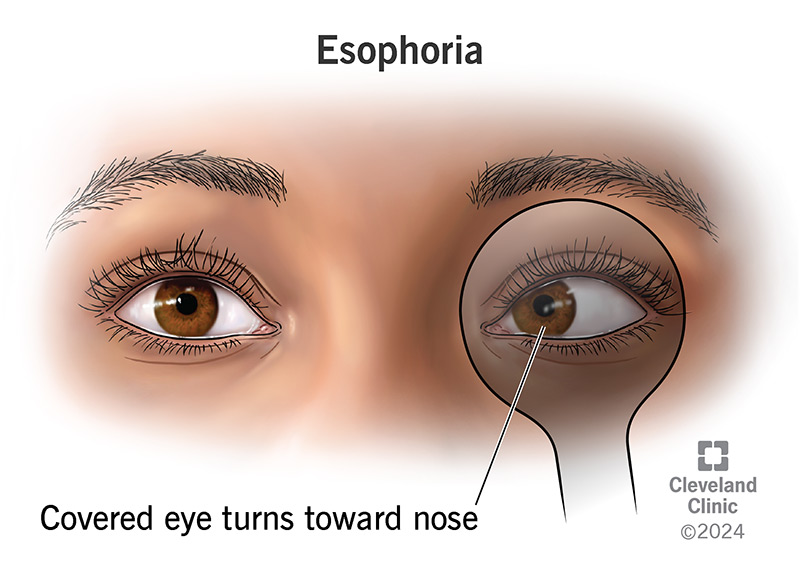Esophoria is when covering one of your eyes makes it drift out of alignment and point inward toward your nose. It’s a symptom that falls under strabismus. When the misalignment is small, it’s normal, and most people don’t notice it. Larger misalignments can cause symptoms or worsen, causing misalignment without covering an eye.
Advertisement
Cleveland Clinic is a non-profit academic medical center. Advertising on our site helps support our mission. We do not endorse non-Cleveland Clinic products or services. Policy

Esophoria is when covering one of your eyes makes it misalign and turn toward your nose. It’s a type of phoria, which is an eye misalignment that happens to an eye when you cover it. Larger phorias, including esophoria, are symptoms that fall under strabismus.
Advertisement
Cleveland Clinic is a non-profit academic medical center. Advertising on our site helps support our mission. We do not endorse non-Cleveland Clinic products or services. Policy
Nearly everyone has at least some amount of phoria, but it’s usually so small that you never notice it. Even when phorias are larger, they’re often much harder to detect because they only happen with one eye covered.
But if phorias get large enough, they can start causing unpleasant symptoms or worsen into misalignments that happen without covering an eye. And how much phoria a person can tolerate varies. A misalignment that doesn’t bother one person could be deeply unpleasant for another.
Your eye alignment is an important part of vision. When your eyes line up, your brain can “fuse” the input from both eyes into the single big-picture 3D view that you see. That’s called binocular vision (stereopsis).
When you have significant esophoria, your brain may struggle to fuse the two pictures. That can cause other, more disruptive symptoms like:
Horizontal (side-to-side) misalignments like esophoria and exophoria are more common than vertical (up-and-down) misalignments. Twisting misalignments (where your eyes rotate more diagonally than vertically or horizontally) are possible but uncommon.
Your brain uses what each eye sees to make subtle adjustments to align and focus them when you’re using both at the same time. So, when you cover one eye, that eye can’t use the same reference points as the uncovered eye. Without reference points, it drifts out of alignment. Small degrees of phoria like this are normal.
Advertisement
Esophoria can also be more likely to develop depending on a few factors, including:
Like most phorias, esophoria usually doesn’t need treatment unless it is severe enough to cause other symptoms. Esophoria may also need treatment if it worsens over time and creates a risk for other eye alignment issues.
Some of the most common treatment options include:
Advertisement
Esophoria isn’t something you can self-diagnose. It takes a trained eye care specialist to diagnose it. Because of that, you shouldn’t try to self-treat it. If you think you have it, an eye care specialist can diagnose you and guide you on how to manage esophoria.
A small amount of esophoria is normal, and it usually doesn’t become an issue unless it’s more severe. When it’s more severe, there’s a risk it can also worsen over time. That’s known as “decompensated esotropia.” And if esophoria decompensates far enough, the misalignment can start happening without covering an eye. That’s known as esotropia, and it has the potential to be even more disruptive because it can happen frequently or even constantly.
Even when esophoria doesn’t decompensate, it can still be unpleasant. The misalignment forces your brain and eye muscles to put extra effort into realigning. That’s why esophoria can cause other symptoms like double vision, headaches and eye strain.
One way to think about it is like the rearview mirror in a car. If it isn’t lined up right, you need to adjust it. Now imagine having to readjust the mirror several or even dozens of times a day. The more you have to fix it, the more disruptive it becomes and the more tired your arm muscles will get.
Advertisement
Most people who have esophoria don’t know they have it, so it’s rare for people to notice it on their own. Instead, other symptoms that happen because of esophoria are usually why people see a healthcare provider or eye care specialist about it, which leads to the provider seeing and diagnosing it. Esophoria is something that eye care specialists can see during routine eye exams, and that pediatricians can see during routine checkups and visits.
If you have frequent headaches, eye strain or fatigue, or notice changes in your vision, it’s a good idea to see an eye care specialist. They can check for esophoria or similar issues and offer treatment recommendations.
Esophoria is an inward-pointing eye misalignment that only happens to an eye when you cover it. Exotropia is when an eye misaligns away from your nose without covering it. They’re both types of eye misalignment, but the misalignments are in different directions and happen for different reasons.
A little esophoria can be normal, but larger misalignments can become unpleasant and interfere with your life. But you don’t have to tolerate esophoria, and it isn’t silly to talk to seek treatment for it. Talking to an eye care specialist can help you feel better and avoid other complications.
Advertisement
Getting an annual eye exam at Cleveland Clinic can help you catch vision problems early and keep your eyes healthy for years to come.

Last reviewed on 02/18/2024.
Learn more about the Health Library and our editorial process.